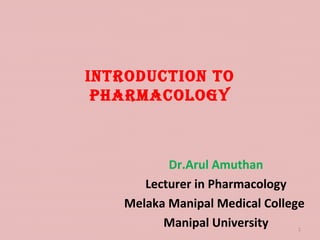
1. introduction, route of administration
- 1. IntroductIon to Pharmacology Dr.Arul Amuthan Lecturer in Pharmacology Melaka Manipal Medical College Manipal University 1
- 2. pharmacology - drug study What is Pharmacology ? Science that deals with the effects of drugs on living system. Sources, biological effects, therapeutic uses, adverse effects and interactions of drugs 2
- 3. What is drug ? Substance that modify the physiological systems or pathological state for the benefit of the recipient. 3
- 4. Pharmacokinetics: What the body does to the drug Absorption, Distribution, Metabolism, Excretion [ADME] 4
- 5. Pharmacodynamics: What the drug does to the body Drug’s mechanism of action Pharmacological effects of drug Adverse effects of drugs Drug interaction 5
- 6. 6 Pharmacotherapeutics: Application of pharmacological information together with disease knowledge for prevention and cure Selection of drug, dose, duration of treatment Toxicology: Harmful effects of drug Detection, prevention, treatment of poisoning Study of adverse effects
- 7. Clinical pharmacology: Scientific study of drugs in man 7 P.kinetic/dynamic investigation in healthy and patients Evaluation of efficacy and safety, adverse effects Comparative trails, Surveillance
- 8. SOURCES OF DRUGS I. Natural sources II. Semisynthetic sources III. Synthetic sources 8
- 9. Plants: Morphine, codeine, atropine, quinine, digoxin Animals: insulin, thyroxine Microorganisms: penicillin, streptomycin Minerals: iron, calcium, zinc I. Natural sources: 9
- 10. II Semisynthetic sources: Ampicillin, Amoxicillin (semisynthetic penicillins) Diacetyl morphine III.Synthetic sources: paracetamol, erythromycin, pethidine 10
- 11. 11 Drug nomenclature: Chemical name - Generic name - Trade name
- 12. 3.Trade name: (brand, proprietary name) Given by a pharmaceutical company Sole property of the pharmaceutical company A drug may have many proprietary names Same company – different name in different countries Prescription, over-the-counter drugs Ecospirin, Disprin (for aspirin) 12
- 13. 2.Generic name: Assigned by - United States Adopted Name (USAN) council British Approved Name (BAN) council Used uniformly in all countries After the drugincludedin pharmacopeia - official name Aspirin, paracetamol 13
- 14. 1. Chemical name: Is the name of chemical compound present in a drug Acetyl salicylic acid, Acetaminophen Not suitable for prescribing Number is given before name is framed (Eg: INR00439) 14
- 15. Sources of drug information Pharmacopeia: Book containing names of officially approved drugs with their physical and chemical characteristics. Eg: Indian Pharmacopoeia (IP) BP, USP 15
- 16. Non-official references: Physicians’ Drug Reference (PDR) Dental Drug Reference (Mosby) Monthly Index of Medical Specialists (MIMS) Medical journals: The Malaysian Journal of Medical Sciences Medical Journal of Malaysia, BMJ US Food and Drug Administration (FDA): www.fda.gov16
- 17. 1. Enteral route: oral, sublingual, rectal routes 2. Parenteral routes: intradermal, subcutaneous, intramuscular, intravenous, intra-arterial, intrathecal 3. Topical: skin and mucous membrane 4. Others: transdermal, inhalational 17 Route of drug administration
- 18. Oral route: Advantages: Safe, convenient for long use Painless, self administered Disadvantages: Slow onset of action (not used in emergency) Not suitable - in diarrhoea/vomiting/unconscious cases - unpalatable/irritant drugs, unabsorbed drug Aspirin, paracetamol, ibuprofen 18
- 19. Sublingual: Advantages: Quick onset of action, bypass first pass metabolism Self administered, terminated by spiting out Disadvantages: In children Bad smell & lipid insoluble drugs Nitroglycerin for angina 19
- 20. Advantages: Unpleasant drugs In vomiting, unconscious cases Disadvantages: Inconvenient, embarrassing Causes rectal inflammation Prednisolone for ulcerative colitis Ergotamine, diazepam for systemic effect 20 Enema (fluid) suppositories (tablets) Rectal:
- 21. Parenteral routes & site: 21
- 22. Intradermal: Disadvantages: Painful, no self administration small amount of drug is administered Eg: BCG vaccine, drug sensitivity tests 22
- 23. Subcutaneous: Advantages: Self administration is possible Depot can be inserted into sc Disadvantages: Slow absorption, not useful in emergency Suitable only for non-irritant drugs Eg: Insulin, adrenaline 23
- 24. Intramuscular: Advantages: Rapid absorption Depot injections 10 ml can be given at a time Useful in vomiting, diarrhea, unconscious patients Bypass first pass metabolism Disadvantages: Sterilization required Painful, no self administration Injury to nerve, cause abscess Eg: gentamicin, streptomycin, kanamycin 24
- 25. Intravenous: Advantages: Directly reaches blood Bypass first pass metabolism, 100% bioavailability Emergency – fast onset of action Large volume infused – iv fluids High irritant drugs is given Useful in vomiting, diarrhea, unconscious patients Eg: furosemide, diazepam 25
- 26. Intravenous: Disadvantages: Once administered, can’t be stopped Painful, no self medication Strict aseptic precautions Extravasation causes tissue necrosis Causes thrombophlebitis 26
- 27. Topical: (skin and mucous membrane) Advantages: More convenient, encouraging to patient Efficiently delivered to local lesion areas Disadvantages: Local irritation, dermatitis silver sulfadiazine ointment, diclofenac gel 27
- 29. Advantages: Self administered, better patient compliance Prolonged duration of action Less systemic side effect Disadvantages: Expensive Local irritation causes dermatitis, itching Patch may fall off unnoticed scopolamine, nitroglycerine, oestrogen 29
- 30. Inhalational: Volatile liquids and gases are given for systemic effects Advantages: Absorption through alveoli, rapid onset of action Less dose is enough, so less systemic toxicity Amount of drug can be regulated Disadvantages: Irritation causes bronchospasm and high secretion General anaesthetics – nitrous oxide, ether, halothane 30
- 31. Drug into subarachnoid space - Intrathecal 31 Intrathecal – lignocaine, amphotericin Intra articular – hydrocortisone
- 32. 33
Hinweis der Redaktion
- http://www.usp.org/usp-nf
- Embarrassing – feel shame, painful Evacuation enema, Retention enema.
